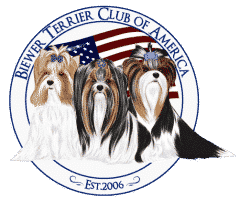I am compelled to write this paper because there seems to be so much confusion about our wonderful Biewer Terrier’s coloring and conformation. What should be used for breeding and what should we put in the show ring? Is this bite accept-able? Are these ears ok? How big is too big? Is there enough black/blue on the back and face? Is that tail curled over the back enough?
These are just some of the questions being asked. I am constantly told that “so and so” should not breed their dog because it is ugly or it’s too big or too small or it doesn’t have enough black/blue on it or the ears are too big, the hair is bad, etc…
First of all, that old saying, “Beauty lies in the eyes of the beholder” holds true with breeding also. I may think a dog is beautiful and you may think it is ugly. Who is right? I’ll tell you who, BOTH. That’s why we have a Biewer Terrier Breed Standard, a description of the dog that we should be breeding towards.
I would like to start out by saying that this is a new breed and it is nowhere near perfection. Big ears can create two significant problems; not only in size, but they may also have poor placement. They will either sit low, which makes them stick out to the sides of the head, or they will be wide-set and they will stick out diagonally. This will take more time and effort to correct, so make sure you breed with dogs that have accurate ear set and size.
Bites create a major challenge when trying to correct. I personally will not breed a dog with a bad bite as it usually takes a few generations to correct. If you do pursue this task, make sure you check the lines behind the mate as far back as possible to ensure that all dogs have had a solid, correct bite. If the dog is HIGHLY exceptional in every other area, I may make an allowance and just make sure that any offspring with bad bites go into pet homes. An undershot/overshot bite can skip a generation and pop up in the next one; this is the reason to check as many generations as possible.
At this time, blue eye(s), brown or liver pigmentation of the eye rims, nose, lips, and pads, and any other color or combination of colors other than those listed are the only disqualifications. Otherwise, all dogs may be shown. However, many would be better off just being used in a breeding program—and not in the show ring—or sitting in a lap of luxury. Acquiring dogs that completely fit the standard is going to take a while, so do not take offense when another breeder tells you that your dog needs more color, the ears are too big, the body or legs are long, and so on.
Do not try to fix all the problems at once either. You may have to work on conformation first and, when you have accomplished this, move onto the next issue that you may have with your dogs. I personally worked on my conformation first, then my ears, and then the coloring. I have my black staying black, with plenty of coloring on the backs, and am now working on getting more brown in the face. The reason I worked on conformation first was that it is the hardest to get perfect.
Coloring can change in one breeding, so I saved it for the last. Don’t get me wrong, I worked on the other issues also, but concentrated on one thing at a time.
Just remember, we have a new breed and it is going to take time to get the Biewer Terrier to the perfect state, figuratively speaking, as no matter how long you breed there will never be a perfect dog. Established breeds have gone through many changes and standards before achieving the look they have today. Keep an open mind and look for people to work with to establish a good, solid breeding program.
Written by Gayle Pruett and Myrna Torres to help breeders with their breeding programs. This article is shared with permission, originally published at: https://biewerterrierclubofamerica.org/developing-a-new-dog-breed/









